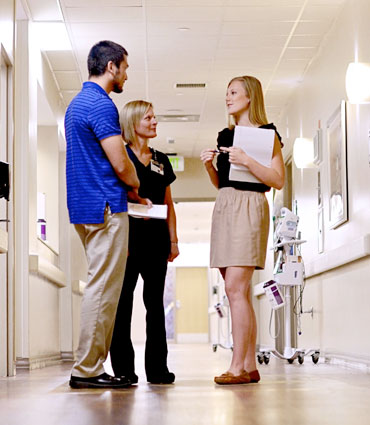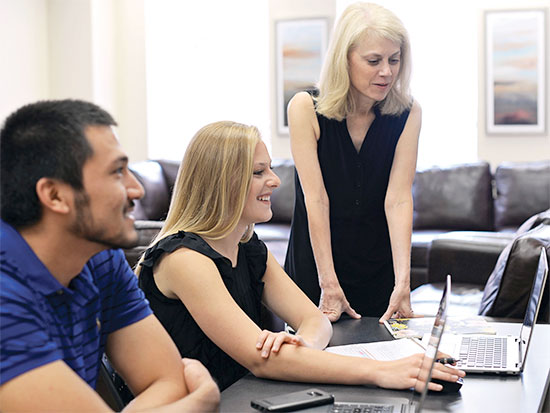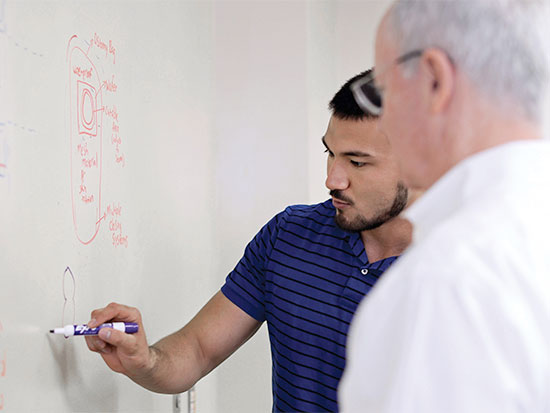Written by: UAB Magazine
Media contact: Tyler Greer
 INFORMATION ACCESS Mentor Kristen Noles, center, connected Ali El-Husari, left, and Paige Severino, right, with UAB ostomy patients, nurses and surgeons.Paige Severino fidgets anxiously in a University of Alabama at Birmingham Hospital hallway. As she grabs another glance around a corner toward a row of doorways, her teammate, Ali El-Husari, takes a deep breath — the only hint of the nerves jangling beneath his calm demeanor.
INFORMATION ACCESS Mentor Kristen Noles, center, connected Ali El-Husari, left, and Paige Severino, right, with UAB ostomy patients, nurses and surgeons.Paige Severino fidgets anxiously in a University of Alabama at Birmingham Hospital hallway. As she grabs another glance around a corner toward a row of doorways, her teammate, Ali El-Husari, takes a deep breath — the only hint of the nerves jangling beneath his calm demeanor.
The two biomedical engineering undergraduates, accompanied by nurse manager and mentor Kristen Noles, D.N.P., are waiting for one of those doors to pop open. And when it does, they have about 20 seconds to sell their idea for a new medical device to Jeffrey Kerby, M.D., Ph.D., UAB’s director of acute care surgery. His reaction will let Severino and El-Husari know if their concept could potentially improve the quality of life for hundreds of thousands of patients — or if they have hit another blank wall. Countless hours of research, brainstorming, scribbling, and second-guessing have led up to this moment of truth.
Finally, a door swings outward. The two students quickly step forward. “Hi, Dr. Kerby,” Severino says eagerly. “Do you have a minute?”
Ostomy 101
|
New eyes on everyday problems
El-Husari and Severino want to change the lives of people who wear ostomy bags, medical devices that help the body expel waste when it is unable to do so on its own. The United Ostomy Associations of America estimate that up to one million people in the United States have a temporary or permanent ostomy, and more than 100,000 new surgeries happen each year. While the bags can help save lives, they aren’t perfect. Sometimes they can leak, smell, or irritate the skin. Even without problems, some people simply find them uncomfortable to wear.
Severino admits she didn’t know what an ostomy was when their journey began. The students first heard about them when Tracie White, D.N.P., a UAB nurse and School of Nursing instructor, brought frustrations shared by patients to UAB Solution Studios — a new forum for clinical innovation. Solution Studios pairs health professionals with students in STEM fields (science, technology, engineering, math) to develop creative solutions for everyday problems affecting patient care. The partners behind it — the UAB Honors CollegeScience and Technology Honors Program, UAB Medicine, and the schools of Engineering and Nursing — have bet that blending clinician expertise and student enthusiasm will spark fresh ideas that can take a fast track to design, testing, and possibly commercialization. The two sides connect online through a kind of matchmaking site, where clinicians post problems and students browse for opportunities to help.
| “Our students are hungry for real-world experience, and they bring fresh eyes to longstanding problems. When these elements come together, it gives hope that these problems will be solved for the good of patients.” |
Joel Berry, Ph.D., explains why the unique combination works so well: Nurses and other health professionals have a keen eye for spotting openings for innovation — new products or processes to improve patient care and outcomes — he says. (Berry, an associate professor of biomedical engineering, is a Solution Studios cofounder and key mentor along with Noles, nurse manager for UAB Hospital’s Clinical Decision Unit, and Nancy Wingo, Ph.D., an assistant professor of acute, chronic, and continuing care nursing.) “But there are too many unmet needs to be solved by clinicians alone,” he explains.
“Our students are hungry for real-world experience, and they bring fresh eyes to longstanding problems. When these elements come together, it gives hope that these problems will be solved for the good of patients.” And further down the road, students trained in the mechanics of innovation can lead the development of an innovation-based economy in Alabama.
“Making even a little difference is a big thing to patients and health professionals experiencing a problem,” Noles adds. While nurses don’t always have the time or knowledge to fix those problems themselves, this partnership gives them an avenue to shape solutions, she says. “We must never stop trying to do more for those who need us.”
Unwrapping ideas
After meeting White and hearing about challenges nurses face in caring for patients with ostomies, Severino and El-Husari quickly became UAB’s youngest experts on the topic, researching everything from medical literature to YouTube videos uploaded by ostomy wearers. In a Solution Studios-linked honors course, Berry encouraged them and other students to be open-minded, tenacious, confident, and to take risks in their thinking.
 A CONCEPT TAKES SHAPE El-Husari and Severino bounce ideas off mentors Nancy Wingo and Joel Berry. Berry encouraged the students to brainstorm without constraints, while Wingo reminded them that innovation doesn’t stick to a schedule. Severino and El-Husari are innovation’s odd couple. While she bubbles over with enthusiasm for the project, delivering data and design ideas in a rapid-fire manner, he is quiet and thoughtful.
A CONCEPT TAKES SHAPE El-Husari and Severino bounce ideas off mentors Nancy Wingo and Joel Berry. Berry encouraged the students to brainstorm without constraints, while Wingo reminded them that innovation doesn’t stick to a schedule. Severino and El-Husari are innovation’s odd couple. While she bubbles over with enthusiasm for the project, delivering data and design ideas in a rapid-fire manner, he is quiet and thoughtful.
“I think out loud,” admits Severino, who has dreamed of an opportunity like Solution Studios since childhood. Back then, the Enterprise, Alabama, resident and her dad would joke about inventing their way to fame and fortune while collaborating on science-fair projects. (Currently Dad is sorry he didn’t think up the fidget spinner first.)
El-Husari, meanwhile, grew up in a tight-knit Birmingham community where he was known for his willingness to lend a hand. “Whenever there was a school project or dinner, I was helping,” he says. “I would set up the tables, help make the meal, and serve it.”
Meshing their personalities into a team went smoothly, they say, because they played to their strengths. Early on, Severino channeled her energy into poring over ostomy statistics while El-Husari patiently compiled an exhaustive list of ostomy products and patents. When it came to brainstorming ideas for new bags, “Paige usually was the first to start talking,” El-Husari says with a grin.
“Then Ali would not really respond, and an hour later, he would say, ‘Have you thought about this?’” Severino recalls. “He could bring me back down to earth.”
Likewise, “when I said something, then Paige would analyze it closely and give good feedback,” El-Husari says.
“We always questioned each other — and ourselves,” Severino adds. “If we had done this alone, we wouldn’t have made progress because it’s easy to get wrapped up in your own idea.”
The power of empathy
One day, Noles burst into the room where Severino and El-Husari were working. A patient with an ostomy problem had come into the emergency department. And he was willing to tell the students all about it. (The students call Noles “the Firecracker” because she seems to know everyone in UAB Hospital and can get them access to almost anywhere they want to go.) The trio sped over to the hospital, where the patient unspooled the whole story of his life with an ostomy. That day, leaks from the bag had irritated the skin on his stomach, causing him to come back for medical help.
Patients like him were eager to talk. Outside the hospital, people typically don’t want to discuss ostomies out of embarrassment. But here, in front of two attentive, inquisitive undergraduates, they felt free to describe how significantly ostomies can alter their lives.
Moments like these add strength and meaning to the Solution Studios “design thinking” strategy that roots innovation in empathy. Listening to patients share their experiences and challenges makes each problem more complex and personal. “It became our problem,” Severino says. “Patients have already gone through so much — maybe they fought colon cancer or Crohn’s disease — and then they have a bag stuck to their body. Making their lives easier was a big motivation.” The students also met with patients’ families, who share the challenges of living with an ostomy, and nurses who teach patients recovering from surgery how to attach, manage, and empty the bags. Severino and El-Husari even wore the bags themselves to see how they felt. “Itchy,” Severino reports. “It left a red ring on my skin for several days.” El-Husari’s bag simply fell off.
Centimeters that matter
The two students recall the summer of 2017 as both exhilarating and frustrating — and then exhilarating again. They, along with another Solution Studios team, had received Presidential Innovation Summer Fellowships from UAB President Ray L. Watts, M.D., to continue the work begun in their honors course. That was exciting, but with each passing day, Severino and El-Husari worried about their progress.
They spent weeks visiting clinics and filling notebooks with sketches of reimagined ostomy bags. Some highlighted the bag itself, while others zeroed in on methods for attaching it to the skin. One day a tornado siren blared, and they exited their study room a little bewildered. Their focus had been so intense that they didn’t realize a storm was brewing.
 The problem with each idea was always the same: El-Husari had identified more than 300 different kinds of ostomy bags already in the marketplace — meaning more than 300 different approaches to the same issues the students were addressing. Some bags used organic honey to prevent skin irritation. Others could filter gases to prevent smells. Severino and El-Husari realized that inventing something unique would be challenging, and even if they succeeded, their product could get lost among the competition, lessening its chances of benefiting patients.
The problem with each idea was always the same: El-Husari had identified more than 300 different kinds of ostomy bags already in the marketplace — meaning more than 300 different approaches to the same issues the students were addressing. Some bags used organic honey to prevent skin irritation. Others could filter gases to prevent smells. Severino and El-Husari realized that inventing something unique would be challenging, and even if they succeeded, their product could get lost among the competition, lessening its chances of benefiting patients.
Then there was the problem within the problem: With more than 300 different kinds of ostomy bags available, why are patients still struggling with ostomies?
Severino and El-Husari looked at one another. They had spent nearly a year trying to reinvent the ostomy bag. But maybe the bag wasn’t the problem at all.
Maybe they needed to reinvent ostomy surgery instead.
Noles connected the students with UAB colorectal surgeons, who let them observe five-hour procedures in the operating room. To form a stoma, which acts as a spout for waste to exit into the ostomy bag, surgeons reroute the intestine through an abdominal opening and fold it over — much like rolling up a shirtsleeve. But not all stomas are created equal, say Severino and El-Husari. Their review of medical and nursing literature revealed a lack of standardization. Some guides call for stomas to be flush with the skin while others recommend that they extend several centimeters. One surgical manual gives no direction beyond “Make the stoma.” They also found that some diagrams used to teach surgeons about stomas unrealistically depict the intestine as a stiff material that can be folded neatly.
Stoma height is crucial. A stoma that is too short means the waste won’t empty into the bag properly, triggering the cascade of complications that can impact health, quality of life, and cost of care. In some cases, the stoma even retracts into the body. Published medical research reports that up to 30 percent of patients are readmitted within 90 days for surgeries to revise their stomas.
The students emphasize that surgeons know what they’re doing and that a lot of planning goes into each procedure. “There simply is a difference in the way the surgeries are performed,” Severino says.
Energized by their discoveries, Severino and El-Husari returned to their sketchbooks with a new idea. This time, they designed a structure — akin to a stent — that surgeons could use as a guide to fold over the intestine at a specific height, creating a more secure stoma to funnel waste into the ostomy bag. “It’s easy to incorporate into current surgery,” Severino says. “Surgeons don’t have to change any techniques.”
Pig skin and thread
Back in the hospital hallway, Severino and El-Husari quickly told Kerby how their invention could standardize stoma surgery and help patients avoid ostomy complications and readmissions. They showed him a prototype made on a 3-D printer at the student-run UAB MakerSpace. Then they proved the concept could work.
Severino opened a Tupperware dish. Inside was a model of a stoma made from pork intestines and pig skin purchased at a local Asian market, all sewn together with curved needles and thread from a big-box store’s craft aisle. The students had assembled the mockup to test their creation. Severino even learned basic surgical techniques to make it look accurate.
| “I smile thinking of these 20-year-olds telling a chief surgeon that they may have a better way to do a complicated procedure,” |
And Kerby’s reaction? “He’s our clinical champion now,” Severino says proudly. UAB ostomy nurses are excited as well. They actually cheered during a presentation about the idea, she says.
“I smile thinking of these 20-year-olds telling a chief surgeon that they may have a better way to do a complicated procedure,” Wingo says. “We told them not to fear failing. Failure means they can move on to the next solution. Paige and Ali took that advice, pivoted their project, and it worked.”
Now, with support from the UAB Medicine Innovation Board, Severino and El-Husari plan to expand their testing. They want to recruit about 20 surgeons to simulate a stoma procedure — both with and without the prototype — on upgraded versions of their model intestine. Then they will survey the surgeons for feedback. At the same time, the students are researching potential materials for constructing their invention.
The resulting data will make a case for commercialization. Severino and El-Husari already are talking with UAB’s Bill L. Harbert Institute for Innovation and Entrepreneurship, which manages technology and other intellectual property developed at UAB. The students’ goal is to gather as much evidence as they can, then pitch their product to companies that could license the technology, earn Food and Drug Administration approval, and manufacture it. Severino says she and El-Husari are eager to meet those company leaders and share the stories of ostomy patients they have met.
Inventing the future
Even if their idea eventually winds up in the hands of every ostomy surgeon, Severino and El-Husari, who are now seniors, won’t end their innovation journey. El-Husari aims to “make things that help a lot of people” while working as a physician.
Severino, eyeing a career in research and development, also plans to keep inventing. “This project has given me the confidence to pursue what I have always wanted to do. Everyone — surgeons, nurses, and patients — believed we could do something about the problem. That was a huge honor.”
More makeovers for careOstomies are just the beginning. Other Solution Studios teams are developing clever concepts that could make their way to a clinic near you. This summer, new groups of Presidential Innovation Fellows—undergraduates in biomedical engineering, biomedical sciences, and public health—took on challenges ranging from monitoring respiratory function among pediatric and elderly patients to preventing sepsis in the hospital environment. And a team of innovation fellows from 2017 continues its collaboration with UAB clinical staff to design more comfortable methods of attaching wires to the skin in settings such as intensive-care units. |
Solution Studios has been a crash course in clinical medicine, engineering, business, communication, and research. It’s a range of experiences and opportunities few undergraduate STEM students get anywhere in the country, Berry notes. But above all, Solution Studios has taught lessons about the ephemeral, neverending nature of innovation itself. Severino says the secret is opening your mind to problems and solutions — and welcoming ideas and responses from a team of collaborators. The days of the lone genius tinkering in a lab are over, she explains. “You have to spit out crazy ideas, have someone knock them down, work together, and never give up until you are 100 percent sure of the problem — and then the solution will come.”
“Innovation is not as easy as everyone makes it out to be,” El-Husari adds quietly. “But you have to stick to it.”
Solution Studios is a registered trademark of UAB.